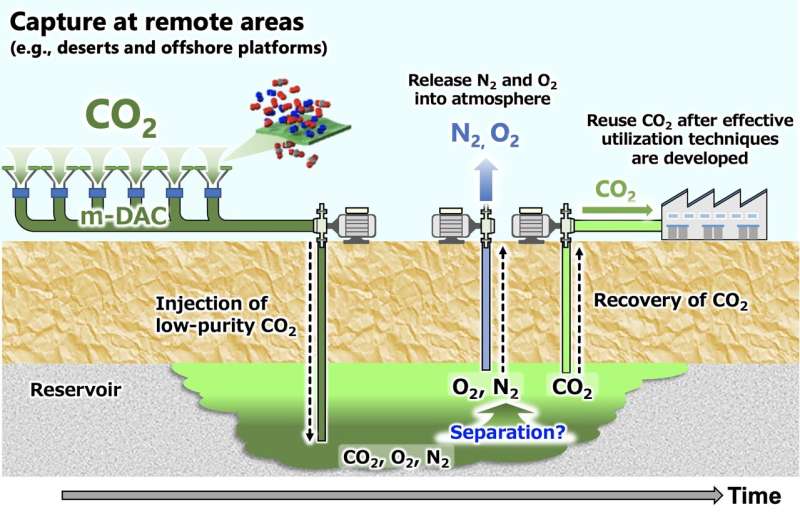Underground storage of carbon captured directly from air—green and economical

The global threat of ongoing climate change has one principal cause: carbon that was buried underground in the form of fossil fuels being removed and released into the atmosphere in the form of carbon dioxide (CO2). One promising approach to addressing this problem is carbon capture and storage: using technology to take CO2 out of the atmosphere to return it underground.
In a new study published in Greenhouse Gases Science and Technology, researchers from Kyushu University and the National Institute of Advanced Industrial Science and Technology, Japan, investigated geological storage of low-purity CO2 mixed with nitrogen (N2) and oxygen NO2), produced by direct air capture (DAC) using membrane-based technology.
Many current carbon capture projects are carried out at localized sources using concentrated CO2 emissions, such as coal-fired power plants, and require intensive purification storage owing to the presence of hazardous compounds such as nitrogen oxide and sulfur oxide. They also have high transportation costs because viable geological storage sites are typically far from the sources of CO2. In contrast, direct air capture of CO2 can be performed anywhere, including at the storage site, and does not require intensive purification because the impurities,NO2 and N2, are not hazardous. Therefore, low-purity CO2 can be captured and injected directly into geological formations, at least in theory.
Understanding how the resulting mixture of CO2,NO2, and N2 behaves when it is injected and stored in geological formations is necessary before underground storage of low-purity CO2 from direct air capture can be widely adopted. As the study's lead author, Professor Takeshi Tsuji, explains, "It is difficult to capture high-purity CO2 using DAC. We performed molecular dynamic simulations as a preliminary evaluation of the storage efficiency of CO2-N2NO2 mixtures at three different temperature and pressure conditions, corresponding to depths of 1,000m, 1,500m, and 2,500m at the Tomakomai CO2 storage site in Japan."
Although further research is still needed, such as investigations of the chemical reactions of injected NO2 and N2 at great depths, the results of these simulations suggest that geological storage of CO2-N2NO2 mixtures produced by direct air capture is both environmentally safe and economically viable.
According to Professor Tsuji, "Because of the ubiquity of ambient air, direct air capture has the potential to become a ubiquitous means of carbon capture and storage that can be implemented in many remote areas, such as deserts and offshore platforms. This is important both for reducing transportation costs and ensuring social acceptance."
More information: Takeshi Tsuji et al, Geological storage of CO2–N2–O2 mixtures produced by membrane‐based direct air capture (DAC), Greenhouse Gases: Science and Technology (2021). DOI: 10.1002/ghg.2099
Provided by Kyushu University



















